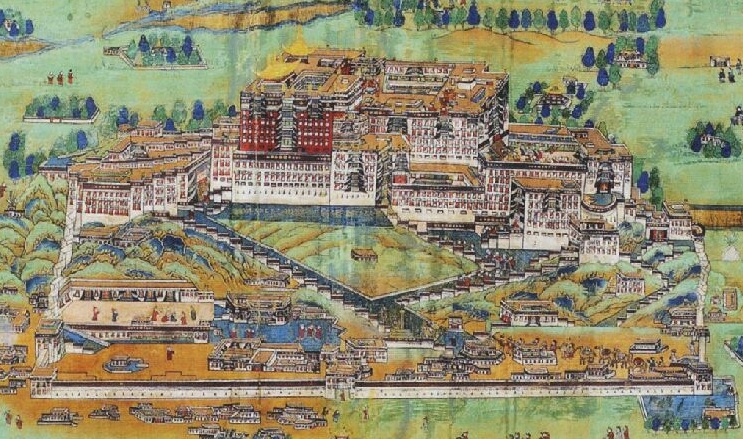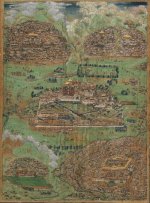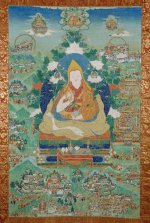
The Potala Palace, named after the mountain home of the bodhisattva Avalokiteśvara, looms high above the city of Lhasa on Marpori (red mountain) to the northwest of the Jokhang. The current structure is thirteen stories tall, making it one of the world's tallest buildings to have pre-existed the modern skyscraper. It is considered a masterpiece that represents the pinnacle of classical Tibetan architectural style and highlights the ingenuity of the Palace's artisans and builders who were constrained by limited resources. It was designated a UNESCO world heritage site in 1994.
The existing palace is largely attributed to the Fifth Dalai Lama, who undertook an immense expansion of the original structure, which is dated to the year 637 during the reign of Songtsen Gampo. Some sources say that the original palace was eleven stories high, although it is possible it was considerably smaller. Several chapels, notably the Pakpa Lhakhang, are said to date from the time of Songsten Gampo. The Fifth Dalai Lama began building the White Palace upon the original foundation in 1645, with construction continuing until 1653. Thousands of workers and artisans hailing from near and far took part in the project. It would become the seat of the Ganden Podrang government (previously located at Drepung), and the winter home of the Dalai Lamas (in summer, they resided at Norbulingka Palace). When the Fifth Dalai Lama passed away in 1682, his Regent, Desi Sanggye Gyatso, continued the expansion and completed the building of the Red Palace in 1694, all the while managing to cover-up the Dalai Lama's death. The structure is located at the center of the White Palace and extends several stories upward. It was used for religious purposes, containing many chapels and halls. Reliquaries for the Fifth Dalai Lama, and the Seventh through twelfth Dalai Lamas are held in the Red Palace.
When Lhasa was attacked by the Dzungars in the early eighteenth century, the Potala was also damaged, and presumably many treasures went missing or were destroyed. Shelling during the Lhasa uprising in 1959 damaged the façade and once again works of art and texts were stolen and destroyed. Since that time, multiple phases of restoration have occurred. Today, the Potala functions as a museum; the influx of tourists presents challenges to ongoing conservation efforts. The Potala was surrounded by a walled neighborhood, the Shol, which was a center of administrative activity and included the Ngul Parkhang (treasury), Makchikhang (armory), Shol Parkhang (Shol printery), to name just a few.


